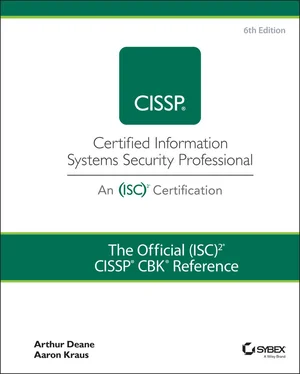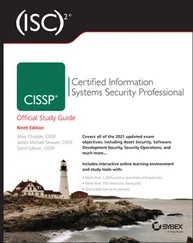Service-Level Requirements
A service-level agreement ( SLA ) is a contractual agreement between a service provider and its customers that establishes the minimum performance standards that the provider is obligated to meet. When dealing with vendors and other third parties, SLAs serve as documented and agreed-upon performance requirements that a customer can use to hold the third party accountable. For example, you may have an SLA with a public cloud provider that commits to a certain level of system uptime and availability. In the event of a sustained outage of the cloud service, you may be entitled to financial compensation or the right to terminate services with no penalty.
Several frameworks explicitly address supply chain risks. This is an evolving area of risk management, but the complexities of managing the information systems supply chain have been evident for many years.
The U.S. government began directly addressing cyber supply chain risk as a separate issue with the publication of NIST IR 7622, “Notional Supply Chain Risk Management Practices for Federal Information Systems.” This work recognizes that the actions required of the entities in the supply chain will change depending on their role, as will the level and type of control to be applied. The document identifies 10 practices that should be taken into account in addressing supply chain risk:
Uniquely identify supply chain elements, processes, and actors.
Limit access and exposure within the supply chain.
Establish and maintain the provenance of elements, processes, tools, and data.
Share information within strict limits.
Perform supply chain risk management awareness and training.
Use defensive design for systems, elements, and processes.
Perform continuous integrator review.
Strengthen delivery mechanisms.
Assure sustainment activities and processes.
Manage disposal and final disposition activities throughout the system or element lifecycle.
The U.S. government has a number of other supply chain risk management initiatives, including the Committee on National Security Systems Directive 505, “Supply Chain Risk Management,” which specifically addresses security requirements for strategic national systems and the Comprehensive National Cybersecurity Initiative Number 11, which provides a set of tools to agencies to manage their cybersecurity supply chain through a risk-driven approach.
ISO 28000:2007, “Specification for security management systems for the supply chain,” provides a broad framework for managing supply chain risk. While not specific to cybersecurity, ISO 28000 is useful for organizations that leverage other ISO specifications (such as ISO 9001 and ISO 27001) to align supply chain risk with the organizations' audit processes or that seek to use a standardized, risk-based approach to evaluating supply chain risk.
ISO 28000:2007 relies heavily on the continuous process improvement model of plan, do, check, act (PDCA) to improve the security management system and to assure organizational conformance to the security practice. This approach facilitates the integration of supply chain risk with broader organizational risk management activities.
U.K. National Cyber Security Centre
The U.K. National Cyber Security Centre (NCSC) proposed guidance that attempts to provide organizations with improved awareness of supply chain risks, while also establishing 12 principles intended to help organizations establish and maintain effective control of their supply chain. The 12 supply chain principles are divided into these separate stages:
1 Understand the risks: The principles in this stage involve identifying your vendors in your supply chain and establishing what needs to be protected in that supply chain (and why).
2 Establish control: This stage involves establishing minimum security requirements (see the earlier section “Minimum Security Requirements”) and communicating your security expectations to your suppliers.
3 Check your arrangements: This stage involves establishing assurance activities and building those into your supply chain processes. This includes establishing audit rights, key performance indicators, and other testing/validation activities.
4 Continuous improvement: This stage involves continually building trust with your suppliers and constantly encouraging security improvements for your supply chain.
ESTABLISH AND MAINTAIN A SECURITY AWARENESS, EDUCATION, AND TRAINING PROGRAM
No matter how many security tools you have in your arsenal, your organization's security is only as strong as its weakest link — and that tends to be your personnel. Information security is one of the few fields that is governed by relatively small teams but is the responsibility of every person within an organization. As such, all personnel within an organization need to be trained and made aware of security threats and attacker techniques so that they know what to look for and how to avoid common pitfalls that can compromise your organization's information security.
Methods and Techniques to Present Awareness and Training
A security awareness program is a formal program that includes processes to train users of the potential threats to an organization's information and systems, as well as educates those users on how to handle such threats. A standard security awareness program should include, at a minimum, new user orientation, lectures or computer-based trainings (CBTs), and printed materials like posters and handouts that share security tips. In addition, organizations can use phishing and other social engineering exercises, security champions, and gamification to help raise awareness of important security topics; each of these is discussed in the following sections.
Social engineering is the practice of human manipulation that involves an attacker pretending to be someone else in an effort to retrieve sensitive data. Phishing is the most common form of social engineering, and it relates to social engineering activities that are conducted over email. Phishing is routinely at the top of the most common security concerns because it can evade many of your most sophisticated security tools and compromise an organization's weakest link — its people.
Simulated phishing campaigns are a popular component of security awareness programs. You should first start by educating your employees on why phishing is harmful and how to spot it. You should conduct randomized simulated phishing exercises to help reinforce the employee training and to help you understand where your risks are (i.e., which types of phishing are most successful on your employees and which employees need further training). Employees who click on a simulated phishing link should be notified and subject to further training that reminds them of how to identify and report signs of phishing.
A security champion is a liaison between an organization's security team and the rest of the company; they are tasked with raising security awareness within the organization. In this role, a security champion is an advocate of security best practices for employees who don't work on security as their primary job. The role of security champion was initially created to raise awareness of application security on software development teams, but nowadays, organizations may frequently choose to assign a security champion to any (or all) nonsecurity teams.
Читать дальше












